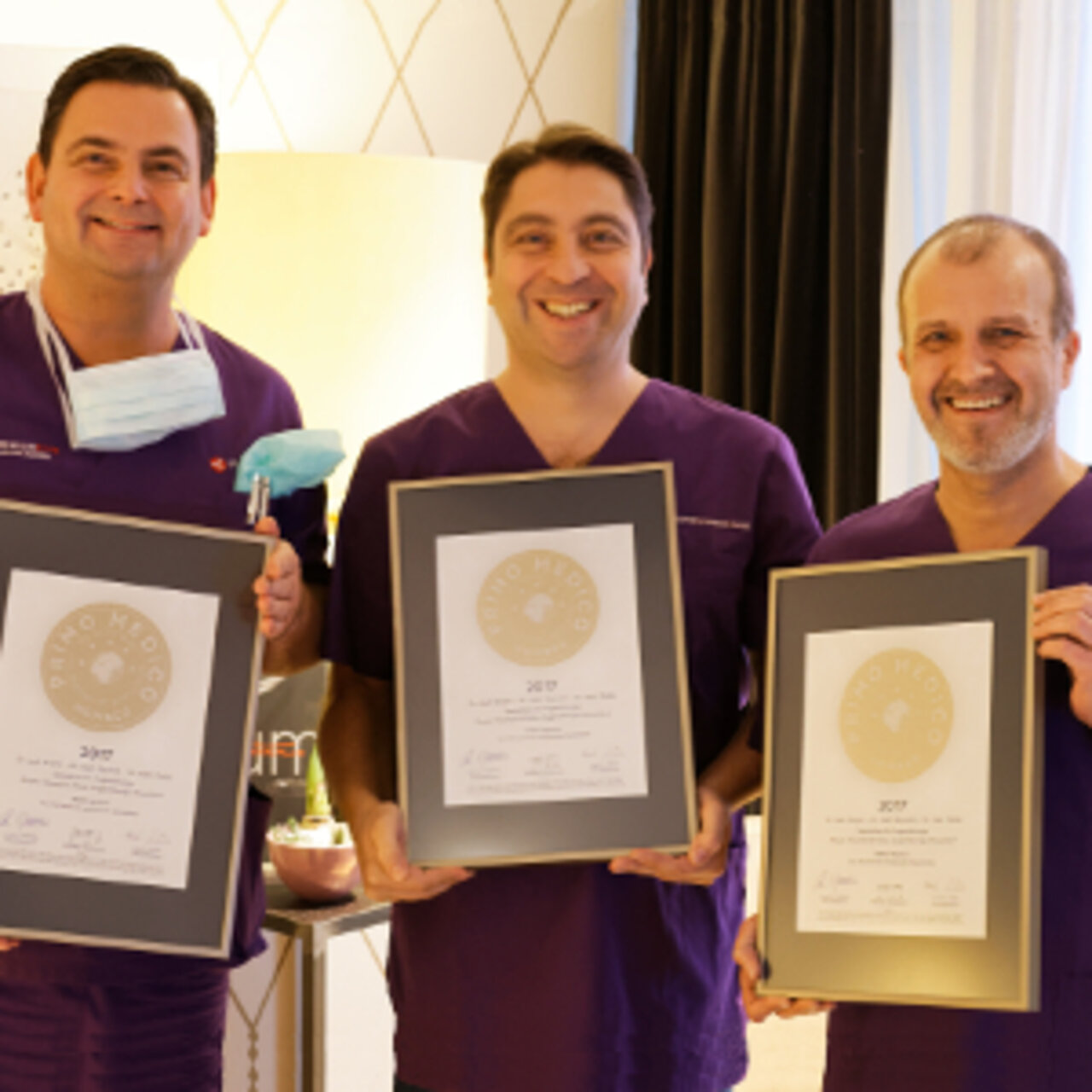Specialists in Retinal Diseases
4 Specialists found
Information About the Field of Retinal Diseases
What Are Retinal Diseases?
The retina is the light-sensitive inner layer of the eye. Diseases of the retina can be congenital or develop during life and often lead to a deterioration of vision.
The retina lines the inside of the eyeball and contains sensory and nerve cells. The sensory cells receive incoming light stimuli and transmit them to the brain via the nerves. There are two types of sensory cells, cones, and rods. The cones are responsible for color vision and brightness vision, while the rods are responsible for twilight vision.
In the retina center is a central spot called the "yellow spot" or "macula lutea" The yellow spot contains a pit, the "foveola," with close cones and no rods. This is the area of sharpest vision and the exit point of the optic nerve.
The retina consists of several layers. The outermost layer, the pigment epithelium, is adjacent to the choroid. The vessels of the choroid supply the retina with oxygen and nutrients.
Adjacent to the pigment epithelium is the layer containing the sensory cells, cones, and rods. Inside are layers of nerve cells. Light first passes through the layers of nerve cells before reaching the rods and cones.
Diseases of the retina can affect the vessels of the retina, the macula, the rods or, the cones. Retinal tears and detachments also occur.
What Are the Different Retinal Diseases?
Major retinal diseases include retinal detachment, age-related macular degeneration, diabetic retinopathy, and retinal vein or artery occlusions. In addition, inflammation and injury of the retina may occur. In children, retinopathy in premature babies and retinoblastoma are significant. Less common retinal diseases include hereditary macular degeneration and retinal dystrophies.
Retinal Detachment
In retinal detachment, the layer containing the sensory cells detaches from the pigment epithelium of the retina. The condition is rare but can have serious consequences. If it is not treated, patients can go blind.
Common causes are degenerative changes in the retina and vitreous humor that cause tears in the retina. Retinal detachment is most common in older people and those with severe myopia. There is also a familial predisposition.
Retinoschisis
Retinoschisis is an age-related fissure in the layers of the retina. Preliminary stages of this condition occur in many elderly people without causing problems. However, the changes are usually not in the retina's center, so visual acuity is preserved. Therefore, retinoschisis usually does not require treatment.
Age-related Macular Degeneration
In age-related macular degeneration, the macula is damaged by an accumulation of metabolic products. The macula is the central area of the retina and the area of sharpest vision. Therefore, the disease can severely affect visual acuity. Macular degeneration occurs frequently. Almost 10 percent of the people in Germany suffer from at least an early stage of age-related macular degeneration.
Diabetic Retinopathy
Diabetic retinopathy is a retinal disease that develops as a result of diabetes. A majority of diabetics develop signs of diabetic retinopathy after many years of diabetes. The increased blood sugar in diabetes damages the retina's small blood vessels in the long run. As a result, hemorrhages develop, and fat and protein are deposited in the retina. In addition, fluid collects in the macula area (macular edema). If the retina is severely damaged, there is a risk of retinal detachment.
Occlusion of the Retinal Vein or Artery
Occlusion of the central vein of the retina occurs mainly in older people. The consequences are moderate to severely impaired vision. The reason for the occlusion is probably sclerotic changes of the vessels. Circulatory disorders are also a possible cause. High blood pressure and increased intraocular pressure may promote vein occlusion. Retinal artery occlusion may be caused by embolism.
Retinopathy in Premature Babies
This retinal disease occurs in premature infants. New blood vessels form in the immature retina and grow into the vitreous body. These vessels distort the retina, and bleeding may also occur. In addition, the traction of the vessels can detach the retina and consequently lead to blindness. Prematurely born children who have to be ventilated are particularly affected.
Retinoblastoma
Retinoblastoma is a malignant retinal tumor and the most common eye tumor in children. It is congenital or develops in the first years of life.
It is usually noticed when the pupil appears white. Then the tumor is already large to the extent that it has grown far into the vitreous body. Cross-eyed vision can also be an indication of retinoblastoma.
Inflammations and Injuries of the Retina
Inflammations of the retina can be caused by viruses, borrelia, fungi, and tiny single-celled parasites called toxoplasmas.
Injuries to the retina occur, for example, when the eyeball is bruised or when sharp objects, such as splinters, enter the eye.
Hereditary Macular Degenerations and Retinal Dystrophies
Hereditary macular degenerations include, among others, Stargardt disease and Best disease. They often occur in childhood or adolescence but can also happen later. The changes in the retina can affect visual acuity to varying degrees.
Hereditary retinal dystrophies are malformations of the cones or rods. Due to a progressive loss of function of these sensory cells, vision deteriorates progressively. Unfortunately, retinal dystrophies are not curable.
What Are the Symptoms of Retinal Diseases?
Blurred vision, distorted vision, and a reduced field of vision are common symptoms of retinal diseases. In addition, patients sometimes see flashes of light, black spots, or shadows in the field of vision. Night blindness or sensitivity to light may also be symptoms.
How Does the Ophthalmologist Diagnose Retinal Diseases?
To detect changes in the retina, the ophthalmologist must look through the patient's pupil to the back of the eye.
This is done with the help of an ophthalmoscope. The ophthalmologist moves the ophthalmoscope as close as possible to the patient's eye. Light from a light source of the ophthalmoscope falls into the patient's eye. This allows the ophthalmologist to see through the pupil to the retina.
To accurately assess the retina, the ophthalmologist looks at the back of the eye magnified through a slit lamp microscope. The slit lamp microscope is a microscope with a lamp used to illuminate the eye. The patient sits directly in front of the microscope during the examination and looks into the device.
Treatments for Retinal Diseases?
In the case of retinal detachment, the therapy depends on the extent of retinal damage. Smaller holes and tears in a still attached retina are closed with a laser to prevent further tear and detachment of the retina. If the retina has already detached, laser treatment of the retina is no longer sufficient. Surgery is required to reattach the retina to the pigment epithelium. First, the doctor sews a "seal" made of silicone rubber onto the sclera from the outside. The seal depresses the eyeball wall from the outside, thereby reattaching the pigment epithelium to the retina. If this is not sufficient, for example, in the case of a large retinal detachment, in addition, removal of the vitreous body (vitrectomy) becomes necessary. Next, the eyeball is filled with a gas or silicone oil. This presses the retina against the eyeball wall from the inside.
In retinal vascular diseases such as diabetic retinopathy and vein occlusion, new poorer functioning vessels form due to the vascular damage and often become fragile. This can lead to hemorrhage in the retina. Therefore, an important goal of retinal vascular disease treatment is to prevent the formation of these new vessels. VEGF inhibitors can be injected into the eye to inhibit new vessel formation. VEGF (Vascular Endothelial Growth Factor) is an endogenous growth factor that stimulates new vessel formation. In addition, the doctor can inject anti-inflammatory steroids into the eye. Laser coagulation also helps prevent new blood vessel formation and bleeding in the retina. In this procedure, the doctor closes blood vessels with a green-light laser.
Retinopathy in premature babies is also treated with laser coagulation. In severe forms of the disease with retinal detachment, vitrectomy is necessary.
Retinoblastoma can be treated by completely removing the eye with the tumor or radiation therapy.
Age-related macular degeneration is a sign of aging and can only be treated to a limited extent. If the disease is accompanied by vascularization of the choroid, VEGF inhibitors are used.
Possible Consequences of Retinal Detachment
Early diagnosis and treatment are essential in retinal detachment. In uncomplicated cases, the prognosis is good. The earlier the disease is detected, the better the chances of recovery. However, even with early treatment, it takes weeks or months for the retina to recover.
Timely therapy is also crucial in diabetic retinopathy. Then it is usually possible to get the disease under control. Nevertheless, people may go blind as a result of the disease.
The prognosis of vein occlusion depends on the degree of damage to the macula and the extent of new vessel formation. Often, vision remains impaired. Complications may include secondary glaucoma, which can lead to blindness.
Retinopathy in premature babies can also lead to blindness in severe cases. But even if the disease could be treated in the babies, long-term consequences can occur. Results may include severe myopia or retinal detachment in adulthood.
Vision is reduced in people with age-related maculopathy, but they do not go completely blind. In addition, magnifying vision aids and magnifying glasses can make reading easier.
Which Doctors and Clinics Specialized in Retinal Diseases?
Every patient suffering from retinal diseases wants the best medical care. Therefore, the patient is wondering where to find the best clinic in Germany or Switzerland.
As this question cannot be answered objectively and a reliable doctor would never claim to be the best one, we can only rely on the doctor's experience. The more retinal surgeries a doctor performs, the more experienced he becomes in his specialty.
Retinal disease specialists are ophthalmologists who specialize in treating the retina. Their experience and years of practice as ophthalmologists specializing in retinology make them the right choice for treatment when the retina is damaged.
Source References:
- Augenheilkunde, F. Grehn, 31. überarbeitete Auflage, Springer Verlag 2012



